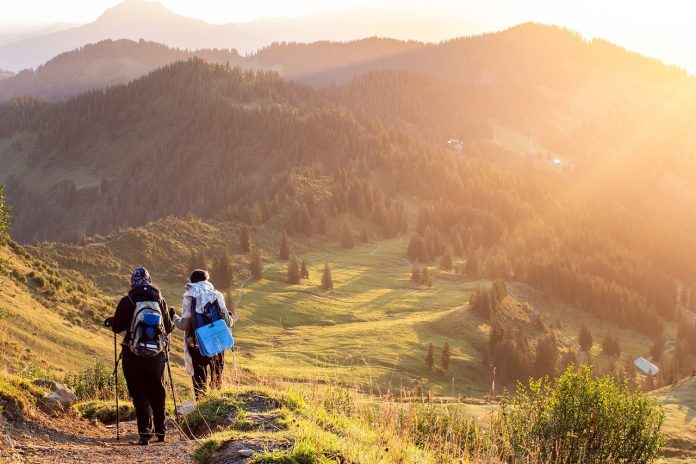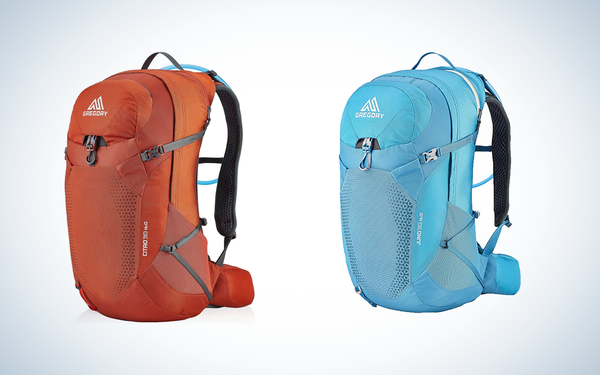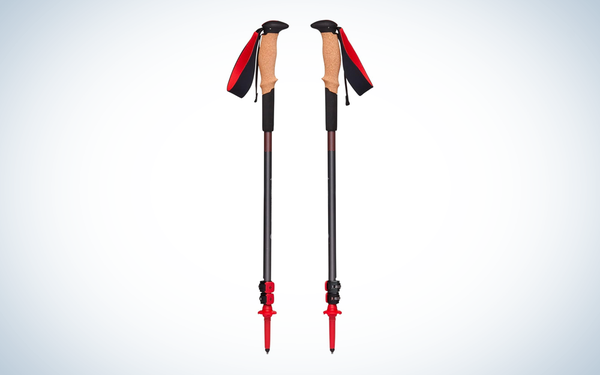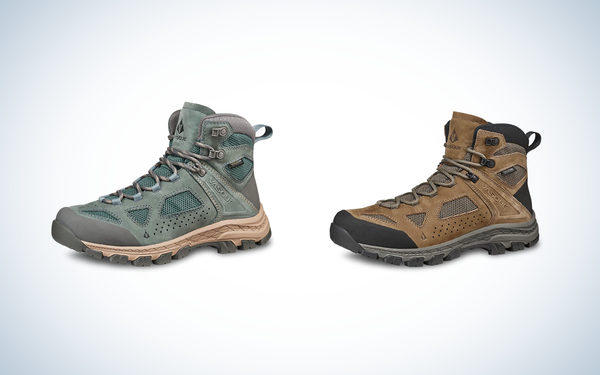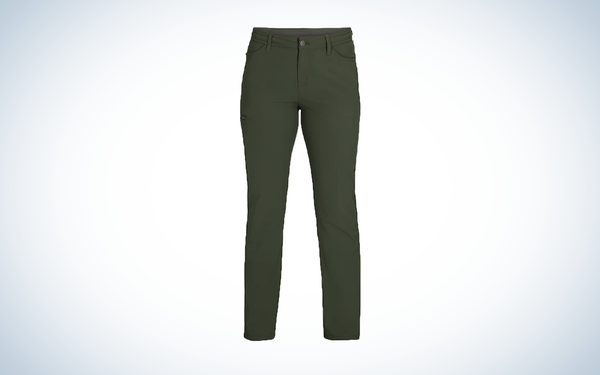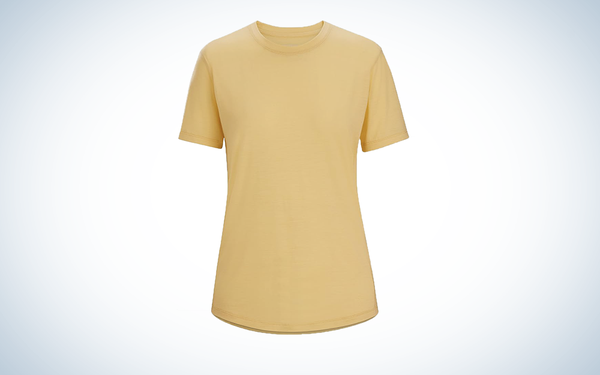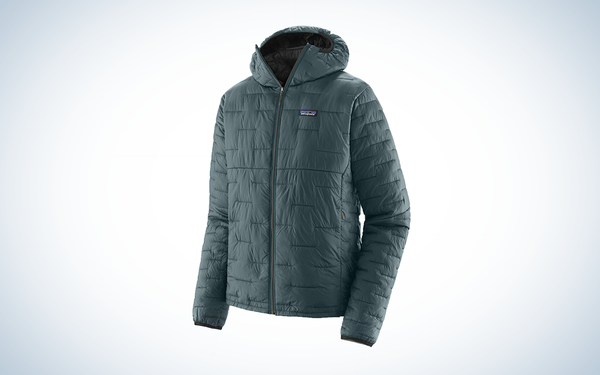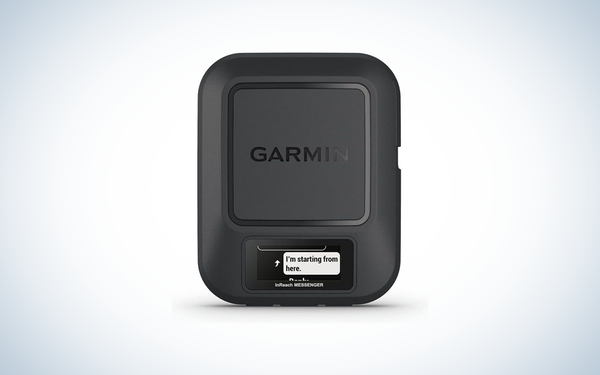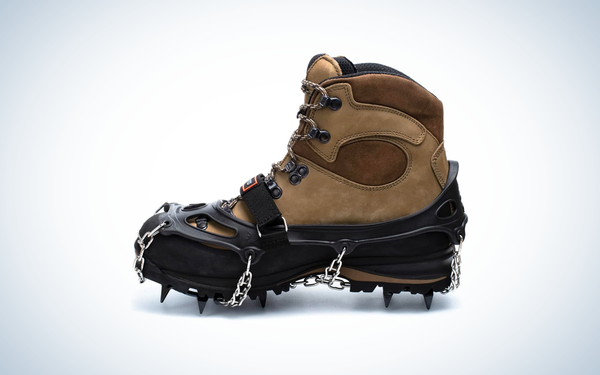We may earn revenue from the products available on this page and participate in affiliate programs. Learn more ›
Whether you’re summiting a peak in the snow or walking a leisurely nature trail in the summer, your gear plays an important role in your comfort, safety, and overall experience. Hiking equipment encompasses a range of products, from durable footwear to breathable hiking shirts to hi-tech safety devices. I put together this list of must-have and go-to products that I take on every hiking expedition. Each piece of equipment below is field-tested from days on the trail. So gear up for your next trip with the best hiking gear you can buy for any type of adventure.
Best Hiking Gear: Reviews and Recommendations
Best Backpack: Gregory Hydration Backpack in Citro for Men / Juno for Women
Specs
- Purpose: Hiking daypack
- Weight: 2.1 lbs
- Optional Features: Color, multiple sizes
- Capacity: 24 L or 30 L option
Pros
- Hydration pouch included
- Ventilated suspension and back panel
- Comfortable fit
Cons
- Large capacity is not necessary for short hikes
After putting hundreds of miles on the Gregory Citro 30 L Hydration Pack, it continues to be my go-to for all-day hikes. My favorite feature is its comfortable fit. The alloy perimeter frame offers stable suspension that equally distributes the load while providing a snug hug in all the right places. Contact with the hiker’s back is limited, but comfortable with a mesh ventilation system—preventing a sweaty back while hiking. The Citro (for men) and Juno (for women) come with a three-liter hydration bladder that easily clips into the zippered hydration pocket. I’ve come to favor Gregory’s bladder system for its durability, easy-fill handling, and drying hook. There is also a front stretchable mesh, mid-zipper pouch, and main compartment. It also has two water bottle exterior pockets, hip belt storage, and a padded top pocket that is perfect for sunglasses or other fragile items.
Best Trekking Poles: Black Diamond Pursuit Shock Trekking Poles
Specs
- Purpose: Stability/Trekking poles
- Weight: 1 lb 2 oz
- Optional Features: Color, grip size, overall size/length
Pros
- Comfortable cork grip
- Shock absorbers for reducing vibration
- Included snow basket
Cons
I started using trekking poles over 15 years ago and have never looked back. This useful item helps me to cover distance on foot while lowering the impact on my knees and feet and improving my balance and stability at the same time. This year, the Black Diamond Pursuit Shock Trekking Poles took the top spot as my everyday poles. Black Diamond designed the poles with a small compression device below the handle that is useful when descending down steep slopes. In addition to this unique feature, the Pursuits boast a collection of optimal characteristics for the frequent trekking pole users. For example, the ergonomic cork grip provides comfort over four seasons, while the spongy wrist straps are comfortable and durable. Lastly, the dependable flick-lock system makes for a reliable closure at the extendable joints.
While the Black Diamond Pursuit Shock poles are perfect for a frequent user like me, their telescoping breakdown design leaves the collapsed poles at 27 inches long, which is arguably too long to stick into a backpack. Therefore, users who only use poles for part of their journey might prefer Z-style folding poles instead.
Best Boot: Vasque Breeze in Women’s / Men’s
Specs
- Purpose: Midweight hiking footwear
- Weight: 2 lb 2 oz per pair
- Optional Features: Color, wide sizing
Pros
- Versatile on a variety of terrain
- Supportive
- Comfortable
Cons
- Heavy compared to lightweight shoes
The Breeze is a midweight traditional hiking boot. It rides above the ankle, is breathable, and has reliable waterproofing. I size on the slightly wider side and found the regular-width shoe to be snug in all the right places. It does take a few hikes to break these boots in, as well as the added task of keeping up with hiking boot maintenance.
But the versatility of this boot is unmatched. I was able to wear them over long miles of backpacking in the summer heat as well as through mud and water in cold shoulder seasons. Even after testing other hiking shoes over the past year, I continuously kept grabbing these boots when I knew it was going to be a challenging and/or more technical hike. The tough leather upper proved to be protective against the rough and rocky terrain I regularly hike in New Hampshire, and the mid and outsole provided comfort and dependable traction. While this is a reliable hiking boot for rugged trails, it’s definitely bulkier and heavier than many of the lightweight hiking shoes that have gained popularity in recent years. That said, if you’re looking for a dependable and well-designed hiking boot, the Breeze is up to the task.
Best Pants: Outdoor Research Ferrosi Hiking Pants in Women’s / Men’s
Specs
- Purpose: Technical hiking pant
- Weight: 1.7 oz
- Optional Features: Color, various length options, sizing, color options
Pros
- Breathable
- Allows for excellent mobility
- Comfortable
Cons
- Not warm enough in cold climates
These technical hiking pants come in men’s and women’s and plenty of sizes to fit all body types. When first trying on the pants, I was reminded of the similar stretch and fabric of my OR hiking jacket. It is exceptionally comfortable—soft, breathable, and just the right amount of stretch. In addition, while these pants appear light and thin, they are also abrasion resistant. I was able to climb and scramble over rough rock without the worry of tearing or scuffing. These pants use a traditional zipper/button closure with an inner drawstring. I found them to be true to size. They are not waterproof; however, they are quick-drying and have a DWR coating to resist rain and water.
Best Shirt: Arc’teryx Merino Hiking Shirt in Women’s / Men’s
Specs
- Purpose: Technical hiking shirt
- Weight: 4.1 oz
- Optional Features: Color, XS-XXL
Pros
- Breathable
- Odor resistant
- Comfortable
Cons
The Arc’teryx merino crew neck is a must-have for the avid hiker. The men’s version (Lonia) and women’s version (Lana) are both lightweight crew T-shirts made of 87 percent wool and 13 percent nylon. While some merino shirts feel itchy and consist of thick, hot wool, the Arc’teryx lower micron count results in a soft and breathable feel—similar to a cotton t-shirt. During testing, I also appreciated the natural odor-resistance of merino as well as the breathability compared to poly-blend counterparts. When it comes to fit, I found the Lana to be comfortably loose for hiking with a standard crew neck tee shape. The only disappointment is the limited color options.
Best Jacket: Patagonia Micro Puff Hoody in Women’s / Men’s
Specs
- Purpose: Mid-layer puffer jacket
- Weight: 9 oz
- Optional Features: Color, XXS-XXL, Hooded/Non-hooded
Pros
- Ultralight
- Warm
- Versatile
Cons
I’ve worn my Patagonia Micro Puff jacket consistently over the last five years and it has yet to let me down. Its warmth, weather resistance, and packability make it a great all-season hiking jacket. It is a mid-layer jacket with Patagonia’s Pluma Fill insulation that is known for having some of the best warmth-to-weight ratios. In addition, the jacket retains its insulative properties when wet—a crucial feature for unpredictable weather. The exterior of the jacket is made of ripstop nylon recycled from old fishing nets. I love that the Micro Puff can pack down into its own pocket, which is both handy and impressive.
Its light weight make it a perfect extra layer to stuff in my pack on a summer hike. In shoulder seasons, its warm, yet breathable and in winter can be used as a mid-layer to sandwich between my base layer and shell. The Micro Puff is also equipped with two spacious front zip pockets and a generous-sized open interior pocket. I find the fit to be a boxy cut, which is less flattering on the female figure, yet overall a true-to-size jacket with multiple choices of flattering colors.
Best Satellite Communicator: Garmin inReach Messenger
Specs
- Purpose: Communication and emergency SOS in the backcountry
- Weight: 4 oz
- Optional Features: Subscription plans vary with features and price
Pros
- Portable/lightweight
- Reliable battery and network
- Versatile as an SOS as well as casual communicating
Cons
- Relies on pairing with a cell phone to communicate
Whether you are frequently in the backcountry or a weekend warrior, this handy gadget deserves a spot in your pack. There are no obvious buttons on this satellite communicator, and the screen is small and limited. That’s because the Messenger works by pairing with your cell phone. Through the Garmin Messenger app, users can send check-in messages, track their location, receive weather forecasts, and, of course, activate an SOS.
I tested the inReach Messenger in the North Cascades National Park this past summer. When a wildfire caused part of the park to close, I was separated from my campsite and had to adapt quickly. Although it wasn’t an emergency, I was able to communicate back and forth with my family, giving them updates and sharing new plans until I was able to get back into cell range. I was overall impressed with the battery life and found that if I turned it off/closed the app between uses, it minimally affected my phone’s battery life. That said, I carry a charging bank on backcountry trips, just in case.
Lastly, those with similar concerns should be assured that while you need to pair it with the cell phone app to send text messages, the Garmin inReach Messenger will allow you to manually activate an SOS with the button on your device. Like other satellite communicators, there is a monthly subscription fee to use the Messenger. Plans range from the $14.95 basic safety plan that includes limits on texting, to the $64.95 a month plan that includes almost unlimited features.
Best Winter Hiking Gear: Hillsound Trail Crampon
Specs
- Purpose: Non-technical traction device
- Weight: 16.3 oz
- Optional Features: Size, color, and other versions with varying spike sizes
Pros
- Dependable
- Durable
- Secure with velcro cross strap
Cons
- Wet snow can ball on spikes
As an active winter hiker, I’ve always relied on ice cleats/microspikes to continue my passions through the long, cold months in the Northeast. Hillsound’s Trail Crampon is the best non-technical ice cleat system I’ve tried so far and my current favorite while summiting peaks of packed snow and ice. The system consists of a flexible elastomer harness that easily slips onto a hiking shoe or winter boot. Durable stainless steel chains attach the carbon steel plate and spike system to the harness. With a good fit, the spikes comfortably weld to the bottom of your boot and provide excellent traction on a variety of winter terrains. Hillsound Trail Crampons have surpassed some of my other picks due to their slightly longer spike length, secure fit, and durability.
While most microspikes are around ⅜ inch, the Trail Crampon is ⅔ inch, which is over a quarter inch longer than competitors. This provides a better grip and a more reliable foothold, especially when on an incline. The addition of a cross-shoe velcro strap eliminates the tendency of microspikes to pop off. Lastly, Hillsound’s dedication to quality makes it one of the most dependable and durable products on the market.
Things to Consider Before Buying Hiking Gear
Like any outdoor hobby, there’s a plethora of products designed and marketed to hikers. Here’s what you need to consider before purchasing new hiking gear:
Type of Hiking
Hiking can refer to everything from a walk in the park to a multi-month thru hike. Don’t get fooled into purchasing items that aren’t necessary for your travels. Make a list of the items you need for your adventure and stick to it.
Terrain and Climate
Choose gear and apparel that fits the prevailing climate and typical terrain. Waterproof gear is essential for wet climates, while lightweight and breathable gear and apparel are necessary for hot climates. If you’re frequently hiking over rugged terrain, choose equally tough materials such as robust footwear and abrasion resistant backpacks.
Durability and Quality
Look for solid stitching, and strong, durable materials. Prioritize reputable brands and value items that provide a warranty. Hiking gear will get beat up and worn down on the trail.
FAQs
Q: What are the most important things to bring hiking?
The most important things to bring hiking are the hikers’ ten essentials. These items will help you plan ahead and be prepared while on your trek. First, pack navigation tools such as a map and compass. Second, you need sun protection, including sunscreen, sunglasses, and a hat. Illumination is essential which includes a headlamp or flashlight. Next, pack a first aid kit, a fire starter (like matches or a lighter), and a multi-tool or knife. Additionally, pack extra food for nutrition and adequate water and/or a water filter. Lastly, include an emergency shelter such as a space blanket or bivvy sack in your pack.
Q: How do you pack a hiking backpack?
Pack your hiking backpack to maximize comfort and convenience. I always begin by placing my heaviest items close to my back and center them to maintain balance. For a backpacking trip, this includes my tent and cookware, but for a day hike, it might be a bulky first aid kit or extra clothing. Stuff extra clothing and gear around these items in an effort to keep the load balanced. Place most-needed items like your camera, navigation, or sunglasses in easy-to-reach pockets. Lastly, attempt to balance your water load equally amongst bilateral water bottle pouches or by utilizing a hydration bladder. Before you hit the trail, tighten compression straps in order to stabilize the load and ensure a comfortable and secure fit.
Q: Can you wear regular clothes for hiking?
While you can wear regular clothes for hiking, there are safety and comfort advantages to choosing specialized hiking apparel. Regular clothes, often made of cotton, may lack the moisture-wicking and quick-drying capabilities needed in order to manage sweat and stay dry. In addition, hiking-specific clothing is designed for breathability, durability, and protection needed for long days of outdoor exposure. Lastly, while some choose to hike in regular shoes, specific hiking footwear can provide essential traction and foot protection over rugged terrain.
Best Hiking Gear: Final Thoughts
Investing in the best hiking gear is a fundamental step towards enhancing the outdoor experience. From reliable safety tools to comfortable footwear to convenient backpacks—the right gear can make a significant difference in your comfort, safety, and enjoyment on the trail.
Why Trust Us
For more than 125 years, Field & Stream has been providing readers with honest and authentic coverage of outdoor gear. Our writers and editors eat, sleep, and breathe the outdoors, and that passion comes through in our product reviews. You can count on F&S to keep you up to date on the best new gear. And when we write about a product—whether it’s a bass lure or a backpack—we cover the good and the bad, so you know exactly what to expect before you decide to make a purchase.

